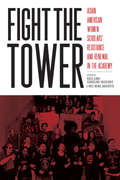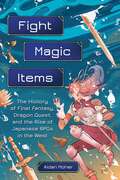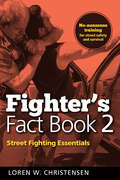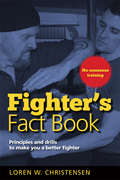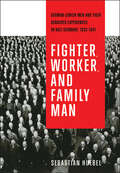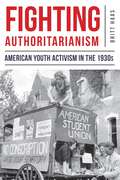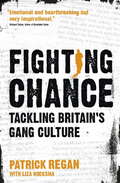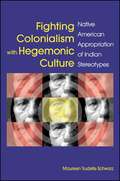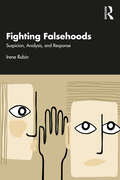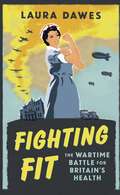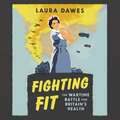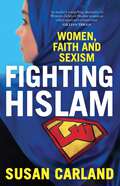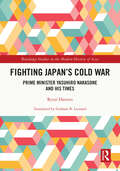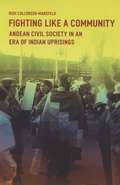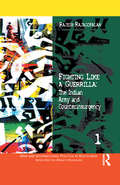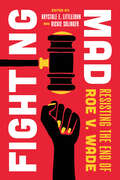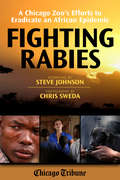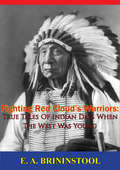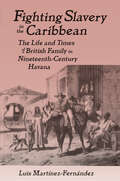- Table View
- List View
Fight the Tower: Asian American Women Scholars’ Resistance and Renewal in the Academy
by Grace J. Yoo Shirley Hune Robyn Magalit Rodriguez Jane Junn Akiko Takeyama W P Kieu Linh Valverde Wei Ming Dariotis Eliza Noh Mai’a K. Cross Cara Maffini Pham Melody Yee Jing Mai Shannon Deloso Kaozong N. Mouavangsou Cindy Nhi Huynh Rani Neutill Brett J. Esaki Melissa-Ann Nievera-Lozano Allyson Tintiangco-Cubales Genevieve Erin O’BrienAsian American women scholars experience shockingly low rates of tenure and promotion because of the particular ways they are marginalized by the intersectionalities of race and gender in academia. Although Asian American studies critics have long since debunked the model minority myth that constructs Asian Americans as the ideal academic subject, university administrators still treat Asian American women in academia as though they will simply show up and shut up. Consequently, because silent complicity is expected, power holders will punish and oppress Asian American women severely when they question or critique the system. However, change is in the air. Fight the Tower is a continuation of the Fight the Tower movement, which supports women standing up for their rights to claim their earned place in academia and to work for positive change for all within academic institutions. The essays provide powerful portraits, reflections, and analyses of a population often rendered invisible by the lies that sustain intersectional injustices in order to operate an oppressive system.
Fight, Magic, Items: The History of Final Fantasy, Dragon Quest, and the Rise of Japanese RPGs in the West
by Aidan MoherTake a journey through the history of Japanese role-playing games—from the creators who built it, the games that defined it, and the stories that transformed pop culture and continue to capture the imaginations of millions of fans to this day.The Japanese roleplaying game (JRPG) genre is one that is known for bold, unforgettable characters; rich stories, and some of the most iconic and beloved games in the industry. Inspired by early western RPGs and introducing technology and artistic styles that pushed the boundaries of what video games could be, this genre is responsible for creating some of the most complex, bold, and beloved games in history—and it has the fanbase to prove it. In Fight, Magic, Items, Aidan Moher guides readers through the fascinating history of JRPGs, exploring the technical challenges, distinct narrative and artistic visions, and creative rivalries that fueled the creation of countless iconic games and their quest to become the best, not only in Japan, but in North America, too. Moher starts with the origin stories of two classic Nintendo titles, Final Fantasy and Dragon Quest, and immerses readers in the world of JRPGs, following the interconnected history from through the lens of their creators and their stories full of hope, risk, and pixels, from the tiny teams and almost impossible schedules that built the foundations of the Final Fantasy and Dragon Quest franchises; Reiko Kodama pushing the narrative and genre boundaries with Phantasy Star; the unexpected team up between Horii and Sakaguchi to create Chrono Trigger; or the unique mashup of classic Disney with Final Fantasy coolness in Kingdom Hearts. Filled with firsthand interviews and behind-the-scenes looks into the development, reception, and influence of JRPGs, Fight, Magic, Items captures the evolution of the genre and why it continues to grab us, decades after those first iconic pixelated games released.
Fighter's Fact Book 2: Street Fighting Essentials
by Loren W. ChristensenNo-nonsense training for street safety and survivalYou will fight how you train. That's why Fighter's Fact Book 2 presents a critical look at training and real-world applications. When you've mastered the skills taught in this book, you will truly be ready to defend yourself in some of the most desperate situations imaginable.You will learn how to defend yourself against multiple assailants, violent dogs, and knife attacks. You'll learn how to contend with close-quarters attacks and adversaries who are impervious to pain. You'll also get no-nonsense instruction on fighting wounded and the justified use of extreme tactics.Loren W. Christensen shares lessons from his decades of martial arts training and law enforcement experience. He has also enlisted a host of expert contributors:* Lt. Col. Dave Grossman* Iain Abernethy* Rory Miller* Kris Wilder* Lawrence Kane* Alain Burrese* Wim Demeere* Richard Dimitri* Mark Mireles* Tim Delgman* Dan AndersonThese men are proven survivors, and their multidisciplinary analyses will change the way you see training and fighting.The authors will show you how to make your street techniques fast and explosive, and how to prepare yourself mentally to use extreme force. These skills are not for the faint of heart. They are hardcore techniques intended to save your life or the life of a loved one.
Fighter's Fact Book: Principles and Drills to Make You a Better Fighter
by Loren W. ChristensenPrinciples and drills to make you a better fighterWith over 45 years of experience in the ring, on the mat, and in the street, Loren W. Christensen understands the daily challenges martial artists face. In this book he has put together a collection of over 400 tips, drills, principles, concepts, and exercises to give you the edge, no matter what style of martial art you practice.Discover quick and innovative ways to improve your punching, kicking, sparring, and self-defense skills--plus dozens of tips to develop speed, power, and flexibility. If you are feeling stuck or bored in your martial arts routine, Loren's no-nonsense style will get you up and training with a fire you have not felt in years. Highlights include:* 10 ways to improve your speed* 5 ways to increase your power* 10 ways to train for self-defense* 10 ways to improve health and fitness* Dozens of tips for improving kicks, blocks, and hand strikes* Guidance on psychological preparationFighter's Fact Book includes hundreds of training methods drawn from the author's vast experience, research, and interviews with top instructors from around the country. This is an essential reference for every martial arts student and instructor.
Fighter, Worker, and Family Man: German-Jewish Men and Their Gendered Experiences in Nazi Germany, 1933–1941 (German and European Studies)
by Sebastian HuebelWhen the Nazis came to power, they used various strategies to expel German Jews from social, cultural, and economic life. Fighter, Worker, and Family Man focuses on the gendered experiences and discrimination that German-Jewish men faced between 1933 and 1941. Sebastian Huebel argues that Jewish men’s gender identities, intersecting with categories of ethnicity, race, class, and age, underwent a profound process of marginalization that destabilized accustomed ways of performing masculinity. At the same time, in their attempts to sustain their conceptions of masculinity these men maintained agency and developed coping strategies that prevented their full-scale emasculation. Huebel draws on a rich archive of diaries, letters, and autobiographies to interpret the experiences of these men, focusing on their roles as soldiers and protectors, professionals and breadwinners, and parents and husbands. Fighter, Worker, and Family Man sheds light on how the Nazis sought to emasculate Jewish men through propaganda, the law, and violence, and how in turn German-Jewish men were able to defy emasculation and adapt – at least temporarily – to their marginalized status as men.
Fighting Authoritarianism: American Youth Activism in the 1930s
by Britt HaasDuring the Great Depression, young radicals centered in New York City developed a vision of and for America, molded by their understanding of recent historical events, in particular the Great War and the global economic collapse, as well as by the events unfolding both at home and abroad. They worked to make their vision of a free, equal, democratic society based on peaceful coexistence a reality. Their attempts were ultimately unsuccessful but their voices were heard on a number of important issues, including free speech, racial justice, and peace. A major contribution to the historiography of the era of the Great Depression, Fighting Authoritarianism provides a new and important examination of U.S. youth activism of the 1930s, including the limits of the New Deal and how youth activists continually pushed FDR, Eleanor Roosevelt, and other New Dealers to do more to address economic distress, more inclusionary politics, and social inequality. In this study, author Britt Haas questions the interventionist versus isolationist paradigm in that young people sought to focus on both domestic and international affairs. Haas also explores the era not as a precursor to WWII, but as a moment of hope when the prospect of institutionalizing progress in freedom, equality, and democracy seemed possible.Fighting Authoritarianism corrects misconceptions about these young activists’ vision for their country, heavily influenced by the American Dream they had been brought up to revere: they wanted a truly free, truly democratic, and truly equal society. That meant embracing radical ideologies, especially socialism and communism, which were widely discussed, debated, and promoted on New York City college campuses. They believed that in embracing these ideologies, they were not turning their backs on American values. Instead, they believed that such ideologies were the only way to make America live up to its promises. This study also outlines the careers of Molly Yard, Joseph Lash, and James Wechsler, how they retracted (and for Yard and Lash, reclaimed) their radical past, and how New York continued to hold a prominent platform in their careers. Lash and Wechsler both worked for the New York Post, the latter as editor until 1980. Examining the Depression decade from the perspective of young activists highlights the promise of America as young people understood it: a historic moment when anything seemed possible.
Fighting Back: What an Olympic Champion's Story Can Teach Us about Recognizing and Preventing Child Sexual Abuse--and Helping Kids Recover
by Kayla Harrison Cynthia S. Kaplan Blaise AguirreTwo-time Olympic gold medalist Kayla Harrison has always been a fighter--yet as a young teen, no one knew she was also a victim. Combining Kayla's powerful story of sexual abuse by her judo coach with science-based information from two renowned therapists, this unique book provides critical guidance for parents and professionals. Learn how to spot the signs that a child or teen is being groomed, why kids stay silent about their trauma, how they struggle with self-blame and the brutal betrayal of a trusted authority figure, and exactly what kind of help they need to recover. No one is more qualified than Kayla and her expert coauthors to explain the impact of child sexual abuse--and what you can do to keep kids safe.
Fighting Chance: Tackling Britain's Gang Culture
by Patrick ReganReports of tragic teenage deaths and gang violence seem to dominate the media, yet rarely do we hear from the young people behind the headlines. Who are they? What makes them join gangs? Is there a way out?FIGHTING CHANCE fearlessly exposes the growing problem of gang culture, challenging us to look past the stereotypes and engage with the young people involved: to mentor them, listen to them and to inspire them to consider a different way of life - before it is too late.Without sensationalising or condemning, FIGHTING CHANCE exposes what drives young people into gangs - including poverty, family breakdown, and the need to belong. But the focus is on the solution: how to prevent people joining gangs in the first place, and how to help those deeply involved find a way out. Patrick Regan not only highlights the work of the individuals and organisations who are already tackling Britain's gang problems but also challenges and inspires us to be part of the answer.
Fighting Colonialism with Hegemonic Culture: Native American Appropriation of Indian Stereotypes
by Maureen Trudelle SchwarzHow and why do American Indians appropriate images of Indianness for their own purposes? How do these representatives promote and sometimes challenge sovereignty for indigenous people locally and nationally? American Indians have recently taken on a new relationship with the hegemonic culture designed to oppress them. Rather than protesting it, they are currently earmarking images from it and using them for their own ends. This provocative book adds and interesting twist and nuance to our understanding of the five-hundred year interchange between American Indians and others. A host of examples of how American Indians use the so-called "White Man's Indian" reveal the key images and issues selected most frequently by the representatives of Native organizations or Native-owned businesses in the late twentieth century and the opening years of the twenty-first century to appropriate Indianness.
Fighting Falsehoods: Suspicion, Analysis, and Response
by Irene RubinThis book offers the reader tools to recognize, analyze, and fight back against the fake news, misinformation, and disinformation that come at us from every corner. This volume: Uses real, lively examples to help readers detect fake news, false claims, suspicious information/data, biased reporting, and hate speech; Demonstrates through case studies where to look for information, what to look for, how to analyze the logic/illogic involved, and uncover the truth value of a story; Discusses fact-checking sites, what they examine, and their reliability; Provides examples and analyzes the components, purposes, and consequences of conspiracy theories; Illustrates the tricks of using numbers/data to mislead readers; Explains what to look for to help decide whether to believe the conclusions of stories based on surveys; Offers a range of concrete, effective responses to dangerous, exaggerated, distorted, and false narratives; Examines policy responses to fake news, disinformation, and misinformation across the world. A key manual to negotiate the information age, this book will be essential reading for students, scholars, and professionals of journalism and mass communication, public policy, politics, and the social sciences. It will also be an indispensable handbook for the lay reader.
Fighting Fascist Spain: Worker Protest from the Printing Press
by Montse FeuIn the 1930s, anarchists and socialists among Spanish immigrants living in the United States created España Libre (Free Spain) as a response to the Nationalist takeover in their homeland. Worker-oriented and avowedly antifascist, the grassroots periodical raised money for refugees and political prisoners while advancing left-wing culture and politics. España Libre proved both visionary and durable, charting an alternate path toward a modern Spain and enduring until democracy's return to the country in 1977. Montse Feu merges España Libre's story with the drama of the Spanish immigrant community's fight against fascism. The periodical emerged as part of a transnational effort to link migrants and new exiles living in the United States to antifascist networks abroad. In addition to showing how workers' culture and politics shaped their antifascism, Feu brings to light creative works that ranged from literature to satire to cartoons to theater. As España Libre opened up radical practices, it encouraged allies to reject violence in favor of social revolution's potential for joy and inclusion.
Fighting Fat: Canada, 1920-1980
by Wendy MitchinsonWhile the statistics for obesity have been alarming in the twenty-first century, concern about fatness has a history. In Fighting Fat, Wendy Mitchinson discusses the history of obesity and fatness from 1920 to 1980 in Canada. Through the context of body, medicine, weight measurement, food studies, fat studies, and the identity of those who were fat, Mitchinson examines the attitudes and practices of medical practitioners, nutritionists, educators, and those who see themselves as fat. Fighting Fat analyzes a number of sources to expose our culture’s obsession with body image. Mitchinson looks at medical journals, both their articles and the advertisements for drugs for obesity, as well as magazine articles and advertisements, including popular "before and after" weight loss stories. Promotional advertisements reveal how the media encourages negative attitudes towards body fat. The book also includes over 30 interviews with Canadians who defined themselves as fat, highlighting the emotional toll caused by the stigmatizing of fatness.
Fighting Financial Crime in the Global Economic Crisis (The Law of Financial Crime)
by Nicholas Ryder Umut Turksen Sabine HasslerMany commentators, regulatory agencies and politicians have blamed the risky behaviour of both financial institutions and their actors for the collapse of the United States sub-prime mortgage market which in turn precipitated the global 'Credit Crunch'. This edited volume explores how financial crime played a significant role in the global economic crisis. The volume features contributions from internationally renowned academic and practitioner experts in the field who pinpoint some of the most important facets of financial crime which have emerged over recent years. Key subjects include: the possibility of criminalising reckless risk-taking on the financial markets; the duty of banks to prevent money-laundering and corruption; the growth of the Shadow Banking System; and the manipulation of LIBOR by banks. The book illustrates the global nature of financial crime, and highlights the complex relationships between regulatory bodies, law enforcement agencies and private actors in the attempt to limit the harmful effect of white collar crime on the stability of the financial sector. This book will be of great use and interest to scholars, practitioners and students within the field of financial crime, banking and finance law, and international political economy.
Fighting Fit: The Wartime Battle for Britain's Health
by Laura DawesAt the beginning of the Second World War, medical experts predicted epidemics of physical and mental illness on the home front. Rationing would decimate the nation's health, they warned; drugs, blood and medical resources would be in short supply; air raid shelters and evacuation would spread diseases; and the psychological effects of bombing raids would leave mental hospitals overflowing. Yet, astonishingly, Britain ended the war in better health than ever before. Based on original archival research and written with wit and verve, FIGHTING FIT reveals an extraordinary, forgotten story of medical triumph against the odds. Through a combination of meticulous planning and last-minute scrambling, Britain succeeded in averting, in Churchill's phrase, the 'dark curse' on the nation's health. It was thanks to the pioneering efforts of countless individuals - doctors, nurses, social workers, boy scouts, tea ladies, Nobel Prize winners, air raid wardens, housewives, nutritionists and psychologists - who battled to keep the nation fit and well in wartime. As Laura Dawes shows, these men and women not only helped to win the war, they paved the way for the birth of the NHS and the development of the welfare state.
Fighting Fit: The Wartime Battle for Britain's Health
by Laura DawesAt the beginning of the Second World War, medical experts predicted epidemics of physical and mental illness on the home front. Rationing would decimate the nation's health, they warned; drugs, blood and medical resources would be in short supply; air raid shelters and evacuation would spread diseases; and the psychological effects of bombing raids would leave mental hospitals overflowing. Yet, astonishingly, Britain ended the war in better health than ever before. Based on original archival research and written with wit and verve, FIGHTING FIT reveals an extraordinary, forgotten story of medical triumph against the odds. Through a combination of meticulous planning and last-minute scrambling, Britain succeeded in averting, in Churchill's phrase, the 'dark curse' on the nation's health. It was thanks to the pioneering efforts of countless individuals - doctors, nurses, social workers, boy scouts, tea ladies, Nobel Prize winners, air raid wardens, housewives, nutritionists and psychologists - who battled to keep the nation fit and well in wartime. As Laura Dawes shows, these men and women not only helped to win the war, they paved the way for the birth of the NHS and the development of the welfare state.Read by Karen Cass, with an introduction read by Laura Dawes(p) 2016 Orion Publishing Group
Fighting Hislam: Women, Faith and Sexism
by Susan CarlandThe Muslim community that is portrayed to the West is a misogynist's playground; within the Muslim community, feminism is often regarded with sneering hostility. Yet between those two views there is a group of Muslim women many do not believe exists: a diverse bunch who fight sexism from within, as committed to the fight as they are to their faith. Hemmed in by Islamophobia and sexism, they fight against sexism with their minds, words and bodies. Often, their biggest weapon is their religion. Here, Carland talks with Muslim women about how they are making a stand for their sex, while holding fast to their faith. At a time when the media trumpets scandalous revelations about life for women from Saudi Arabia to Indonesia, Muslim women are always spoken about and over, never with. In Fighting Hislam, that ends.
Fighting Invisibility: Asian Americans in the Midwest
by Monica Mong TrieuIn Fighting Invisibility, Monica Mong Trieu argues that we must consider the role of physical and symbolic space to fully understand the nuances of Asian American racialization. By doing this, we face questions such as, historically, who has represented Asian America? Who gets to represent Asian America? This book shifts the primary focus to Midwest Asian America to disrupt—and expand beyond—the existing privileged narratives in United States and Asian American history. Drawing from in-depth interviews, census data, and cultural productions from Asian Americans in Ohio, Wisconsin, Nebraska, Minnesota, Illinois, Iowa, Indiana, and Michigan, this interdisciplinary research examines how post-1950s Midwest Asian Americans navigate identity and belonging, racism, educational settings, resources within co-ethnic communities, and pan-ethnic cultural community. Their experiences and life narratives are heavily framed by three pervasive themes of spatially defined isolation, invisibility, and racialized visibility. Fighting Invisibility makes an important contribution to racialization literature, while also highlighting the necessity to further expand the scope of Asian American history-telling and knowledge production.
Fighting Japan's Cold War: Prime Minister Yasuhiro Nakasone and His Times (Routledge Studies in the Modern History of Asia)
by Ryuji HattoriYasuhiro Nakasone, who served as prime minister for more than five years in the 1980s, was one of Japan’s leading postwar politicians. This book is a biography of him but, by interweaving in international politics and media appraisals of him, it also serves as an examination of Japan’s postwar politics. Nakasone was an innovative conservative who actively criticized the conservative mainstream, and this book reveals from both domestic and foreign policy perspectives how the Liberal Democratic Party governed. The Nakasone government served as not only the final phase of the Cold War era of LDP factional politics but also as the starting point for the general mainstream faction system that followed. With the lengthy passage of time since the end of the Cold War and the collapse of Japan’s 1955 party system, there is a need to reassess Nakasone, showing that there was much more to him than the popular picture of him as a far-right hawk who loudly advocated for Japan to engage in autonomous self-defense and as an opportunist leader of a small faction, and to place the era in which Nakasone lived its proper historical context.
Fighting Like a Community: Andean Civil Society in an Era of Indian Uprisings
by Rudi Colloredo-MansfeldThe indigenous population of the Ecuadorian Andes made substantial political gains during the 1990s in the wake of a dynamic wave of local activism. The movement renegotiated land development laws, elected indigenous candidates to national office, and successfully fought for the constitutional redefinition of Ecuador as a nation of many cultures. Fighting Like a Community argues that these remarkable achievements paradoxically grew out of the deep differences--in language, class, education, and location--that began to divide native society in the 1960s. Drawing on fifteen years of fieldwork, Rudi Colloredo-Mansfeld explores these differences and the conflicts they engendered in a variety of communities. From protestors confronting the military during a national strike to a migrant family fighting to get a relative released from prison, Colloredo-Mansfeld recounts dramatic events and private struggles alike to demonstrate how indigenous power in Ecuador is energized by disagreements over values and priorities, eloquently contending that the plurality of Andean communities, not their unity, has been the key to their political success.
Fighting Like a Guerrilla: The Indian Army and Counterinsurgency (War And International Politics In South Asia Ser.)
by Rajesh RajagopalanThis book deals with two significant issues: the peculiar and paradoxical question of why regular armies, better suited to fighting conventional high-intensity wars, adopt inappropriate measures when fighting guerilla wars; and the evolution of the Indian army’s counterinsurgency doctrine over the last decade. In addition, the book also includes the first detailed analysis of the trajectory of the army’s counterinsurgency doctrine, arguing that while it was consolidated only over the last decade, the essential elements of the doctrine may in fact be traced back to the army’s first confrontation with the Naga guerillas in the 1950s. It outlines the three essential elements that make up the Indian army’s counterinsurgency doctrine:that there are no military solutions to an insurgency;that military force can only help to reduce levels of violence to enable political solutions; andthat there should be limited use of military force.Rajagopalan argues that international circumstances — particularly the need to counter conventional military threats from Pakistan and China — led to a counterinsurgency doctrine that had a strong conventional war bias. This bias also conditioned the organisational culture of the Indian army.
Fighting Mad: Resisting the End of Roe v. Wade (Reproductive Justice: A New Vision for the 21st Century #8)
by Krystale E. Littlejohn and Rickie SolingerA fierce and galvanizing reminder that resistance is everywhere in the fight for abortion and reproductive justice in the United States. Fighting Mad is a book about what "reproductive justice" means and what it looks like to fight for it. Editors Krystale E. Littlejohn and Rickie Solinger bring together many of the strongest, most resistant voices in the country to describe the impacts of the Supreme Court's Dobbs decision on abortion access and care. The essayists and change agents gathered in Fighting Mad represent a remarkable breadth of expertise: activists and artists, academics and abortion storytellers, health care professionals and legislators, clinic directors and lawyers, and so many more. They discuss abortion restrictions and strategies to provide care, the impacts of criminalization, efforts to protect the targeted, shortcomings of the past, and visions for the next generation. Fighting Mad captures for the social and historical record the vigorous resistance happening in the early post-Roe moment to show that there are millions on the ground fighting to secure a better future.
Fighting Poverty: Caring for Children, Parents, the Elderly and Health (Routledge Revivals)
by Stein Ringen Philip R. DejongFirst published in 1999, this volume is the fifth in a series on international studies of issues in social security. The series is initiated by the Foundation for International Studies on Social Security (FISS). One of its aims is to confront different academic approaches with each other, and with public policy perspectives. Another is to give analytic reports of cross-nationally different approaches to the design and reform of welfare state programs.
Fighting Rabies
by Steve Johnson Chris SwedaThis book comprises a series of Chicago Tribune articles on the Lincoln Park Zoo's partnership with the Serengeti Health Initiative to eradicate the spread and infection rate of rabies in Tanzania. Complete with full-color photography of the villagers, their homes, and the surrounding African wildlife and landscapes, Fighting Rabies is a powerful and illustrative investigation into the efforts to eliminate a vicious disease in a ravaged community.Over 70,000 people die every year from rabies infections, many of whom live in remote and impoverished areas of Africa. This epidemic-prevalent in communities close to wildlife but limited in their access to health and veterinary care-is particularly tragic because rabies can be significantly limited and even prevented through modern medicine. In fact, several developed countries are now completely rabies-free, while developing nations still face unnecessarily high rates of mortality from the disease.Fighting Rabies explores the stories of the villagers who have been victimized by rabies, as well as the efforts of researchers from the Lincoln Park Zoo to inoculate dogs against the virus and rebuild the surrounding populations of wild animals. This is a captivating and moving story of bridging cultures for a greater good, and creating better living conditions for both people and the neighboring wildlife.
Fighting Red Cloud’s Warriors: True Tales Of Indian Days When The West Was Young
by E. A. BrininstoolTHE winning of the West was no child's play! It was war--war of the most brutal and inhuman type on the part of both Indians and whites. The Indian was fighting for his home, his commissary, his lands--lands ceded him through solemn treaty with the United States government--and what man, of any nation (if he is any sort of man) will not fight "for home and native land"?The white man fought to advance the cause of civilization, irrespective (in most instances) of the rights of the Indian, and without regard to his future existence. Civilization won--and to civilization's shame, it was at the cost of unnumbered thousands of lives and the shedding of much human blood of both whites and reds.I am not a believer in the old adage that "the only good Indian is a dead Indian." My sympathy is with the red man. The early white traders who trafficked with the Indian were, as a rule, a class of men of little conscience and few scruples, who would stoop to any deceit or trickery to rob the Indian of his furs and pelts. It was the early trader who introduced whiskey among the Indian tribes; who, through fraud and knavery, turned the red man against the whites of whatever class. This was the beginning of the hatred and contempt which made all white men, good or bad, soon look alike to the warring savage.In this volume of the "Frontier Series" I have written of a few of the most noted battles between the red man and the white man. As in the previous volume, no fiction is employed in these pages. Every incident related actually occurred, and is a part of the history of the old West. Some biographical sketches of noted frontier characters are included. The chapter on the destruction of the buffalo may well make the present-day sportsman pause and reflect.
Fighting Slavery in the Caribbean: Life and Times of a British Family in Nineteenth Century Havana
by Luis Martinez-FernandezThis volume presents a social history of life in mid-19th-century Cuba as experienced by George Backhouse (and his wife, Grace), who served on the British Havana Mixed Commission for the Suppression of the Slave Trade. Documented with extracts from the Backhouse's correspondence, diaries and other contemporary papers, Martinez-Fernandez paints a detailed picture of the Cuban slave trade, its role in the sugar industry, and the interrelated contradictions within Cuba's economy, society and politics. The Backhouse story provides addition al insights into important aspects of life in the "male" city of Havana, social antagonisms between Britons and North Americans, interactions with European social circles, religious tension, and the reality of tropical disease. Drama is added to the narrative in the author's description of the tragic and mysterious murder of George Backhouse in August 1855, possibly the result of a slave traders' conspiracy.
